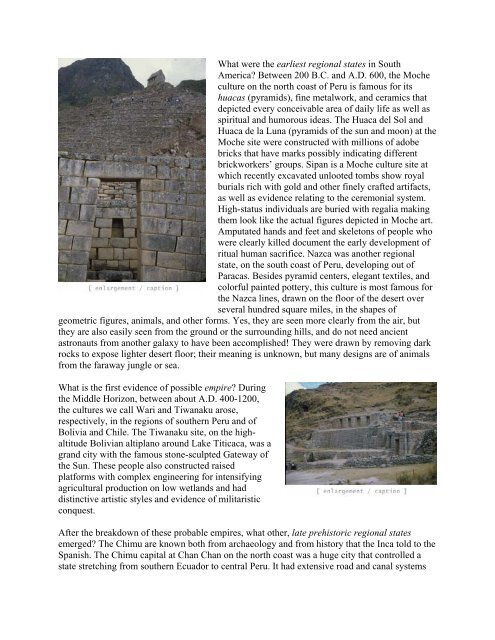INTRODUCTION TO ARCHAEOLOGY Nancy White - Touro Institute
INTRODUCTION TO ARCHAEOLOGY Nancy White - Touro Institute
INTRODUCTION TO ARCHAEOLOGY Nancy White - Touro Institute
Create successful ePaper yourself
Turn your PDF publications into a flip-book with our unique Google optimized e-Paper software.
What were the earliest regional states in South<br />
America? Between 200 B.C. and A.D. 600, the Moche<br />
culture on the north coast of Peru is famous for its<br />
huacas (pyramids), fine metalwork, and ceramics that<br />
depicted every conceivable area of daily life as well as<br />
spiritual and humorous ideas. The Huaca del Sol and<br />
Huaca de la Luna (pyramids of the sun and moon) at the<br />
Moche site were constructed with millions of adobe<br />
bricks that have marks possibly indicating different<br />
brickworkers’ groups. Sipan is a Moche culture site at<br />
which recently excavated unlooted tombs show royal<br />
burials rich with gold and other finely crafted artifacts,<br />
as well as evidence relating to the ceremonial system.<br />
High-status individuals are buried with regalia making<br />
them look like the actual figures depicted in Moche art.<br />
Amputated hands and feet and skeletons of people who<br />
were clearly killed document the early development of<br />
ritual human sacrifice. Nazca was another regional<br />
state, on the south coast of Peru, developing out of<br />
Paracas. Besides pyramid centers, elegant textiles, and<br />
colorful painted pottery, this culture is most famous for<br />
the Nazca lines, drawn on the floor of the desert over<br />
several hundred square miles, in the shapes of<br />
geometric figures, animals, and other forms.<br />
Yes, they are seen more clearly from the air, but<br />
they are also easily seen from the ground or the surrounding hills, and do not need ancient<br />
astronauts from another galaxy to have been accomplished! They were drawn by removing dark<br />
rocks to expose lighter desert floor; their meaning is unknown, but many designs are of animals<br />
from the faraway jungle or sea.<br />
What is the first evidence of possible empire? During<br />
the Middle Horizon, between about A.D. 400-1200,<br />
the cultures we call Wari and Tiwanaku arose,<br />
respectively, in the regions of southern Peru and of<br />
Bolivia and Chile. The Tiwanaku site, on the high-<br />
was a<br />
altitude Bolivian altiplano around Lake Titicaca,<br />
grand city with the famous stone-sculpted Gateway of<br />
the Sun. These people also constructed raised<br />
platforms with complex engineering for intensifying<br />
agricultural production on low wetlands and had<br />
distinctive artistic styles and evidence of militaristic<br />
conquest.<br />
After the breakdown of these probable empires, what other, late prehistoric regional states<br />
emerged? The Chimu are known both from archaeology and from history that the Inca told to the<br />
Spanish. The Chimu capital at Chan Chan on the north coast was a huge city that controlled a<br />
state stretching from southern Ecuador to central Peru. It had extensive road and canal systems
















